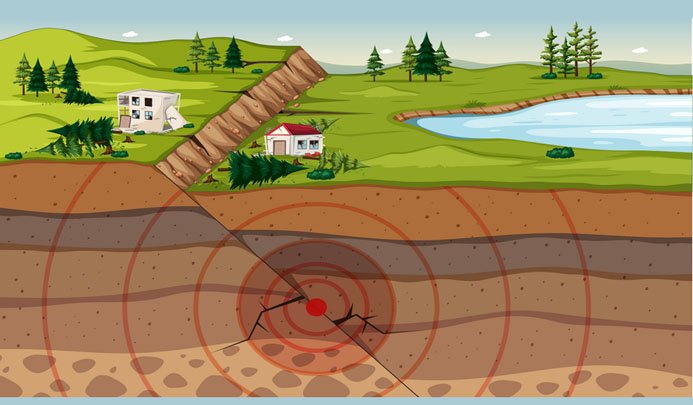JOSHIMATH SINKING
WHY IN NEWS?
- Recently the subsidence or sinking of land in Joshimath, in the border district of Chamoli, Uttrakhand has raised alarms and created a situation of huge panic among the residents.
WHAT IS LAND SUBSIDENCE?
- According to the National Oceanic and Atmospheric Administration (NOAA), subsidence is the “sinking of the ground because of underground material movement”.

Land Subsidence
- It can happen for a host of reasons, man-made or natural, such as the removal of water, oil, or natural resources, along with mining activities.

- Earthquakes, soil erosion, and soil compaction are also some of the well-known causes of subsidence.
- It can happen over very large areas like whole states or provinces, or very small areas like the corner of your yard.”
JOSHIMATH SUBSIDENCE:
- The town falls in high risk seismic zone-5 and is traversed by running streams with a high gradient from Vishnuprayag, a confluence of the Dhauliganga and the Alaknanda rivers.
- As per Mishra Committee Report (1976), the land upon which the town is founded is deposit of sand and stone, the remnants of an ancient landslide, which doesn’t have high load-bearing capacity.
- This makes the area extremely vulnerable to ever-burgeoning infrastructure and population.
- The town is not actually built on the “main rock” of the mountain.
- Joshimath noticed a movement in the cracks and new cracks as well, with several cropping up inside homes for the first time after the deluge of Rishiganga-Dhauliganga rivers.
- Almost a week after cracks appeared in many roads and hundreds of houses in Joshimath, Uttarakhand, authorities on Sunday declared it a landslide and subsidence-hit zone.
- Evacuation plans are on the way and government has ordered 4000 pre-fabricated homes to help the residents.
POSSIBLE CAUSES OF THIS SUBSIDENCE:
- NEGLIGENCE AND POOR POLICIES: This unfolding of disaster is at least partially because of poor policies, and ignoring ecology for short-term profits.
- UNSUSTAINABLE DEVELOPMENT: Incident might have occurred because of unplanned construction of highways and railway tracks, over-population, obstruction of the natural flow of water.
- The construction of the 520 MW NTPC Tapovan Vishnugad Hydro Power plant has been one of the biggest reason of this disaster. As during the construction of the tunnel, a boring machine had perforated a water bearing stratum on the left bank of the Alaknanda river near Shelong village, leading to discharge of 60 70 million litres per day.

- Construction along the Helang bypass to build an all-weather road is also believed to have disturbed the mountain’s foundation.
- UNPLANNED CONSTRUCTION: As most of the houses in the area are constructed without any permission. Only those who need loans from banks get the maps passed from the local development authority.
- Subsidence in Joshimath might have been triggered by the reactivation of a geographic fault system.
- Erratic rainfall and ecological degradation associated with land use change for infrastructural development.
- Due to lack of proper drainage system as accumulated water seeps into the rocks below and softens them.
HOW TO PREVENT SUCH EVENTS:
- National Disaster Management Authority (NDMA) report on the Chamoli disaster in April 2022 clearly states that “in the long term, it will be necessary to focus on finding alternative sources of energy, as the area appears to be environmentally sensitive”.
- AFFORESTATION: Trees are important as they act as mechanical barriers to rain, increase the water conservation capacity and also hold the loose debris mass.
- Rather than building massive dams, focus should be on small projects that would be helpful in providing local energy supply.
- The tourism in such areas should be sustainable tourism not mass tourism.
- RIVER TAMING: The construction of structures to guide the river’s flow should be carried out. Hanging boulders on the foothills should be provided with appropriate support.
- As the Mishra committee report also pointed out that undercutting by the currents of the Alaknanda river makes the area even more prone to disasters.
- PROPER DRAINAGE: The construction of a pucca drain system is a vital necessity as to prevent water from accumulating in the rock crevices.
- Heavy construction work should only be allowed after examining the load-bearing capacity of the soil.
WAY FORWARD:
- Joshimath area is on permanent tectonic zones and water seepage in this area is profuse. Therefore, to prevent any more landslides in the future, it is a must to stop the seepage of open rainwater below.
- Government should be highly cautious while planning new constructions as himalayan environment is at a tipping point and it may not be able to withstand another push generated by intrusive anthropogenic activities.
- An appropriate strategy by the government should be launched for human wellbeing, use of traditional knowledge, organic and sustainable agricultural practices, construction practices and local cultural aspects.
Syllabus : GS3, Environmental disasters and security.


